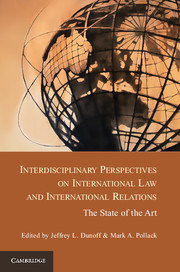 Interdisciplinary Perspectives on International Law and International Relations
Interdisciplinary Perspectives on International Law and International Relations Book contents
- Frontmatter
- Contents
- Contributors
- Acknowledgments
- Part I Introduction: Setting the Stage
- Part II Theorizing International Law
- Part III Making International Law
- 7 Flexibility in International Agreements
- 8 Hard and Soft Law
- 9 Nongovernmental Organizations in International Relations (Theory)
- 10 Regulatory Networks
- 11 Law-Making by International Organizations
- 12 Institutional Proliferation and the International Legal Order
- 13 Legitimacy in International Law and International Relations
- Part IV The Interpretation and Application of International Law
- Part V Enforcement, Compliance, and Effectiveness
- Conclusions
- Index
- References
12 - Institutional Proliferation and the International Legal Order
Published online by Cambridge University Press: 05 January 2013
- Frontmatter
- Contents
- Contributors
- Acknowledgments
- Part I Introduction: Setting the Stage
- Part II Theorizing International Law
- Part III Making International Law
- 7 Flexibility in International Agreements
- 8 Hard and Soft Law
- 9 Nongovernmental Organizations in International Relations (Theory)
- 10 Regulatory Networks
- 11 Law-Making by International Organizations
- 12 Institutional Proliferation and the International Legal Order
- 13 Legitimacy in International Law and International Relations
- Part IV The Interpretation and Application of International Law
- Part V Enforcement, Compliance, and Effectiveness
- Conclusions
- Index
- References
Summary
Since the cataclysm of World War II, the international order has grown increasingly institutionalized. Hundreds of international organizations (IOs) and tens of thousands of treaties now exist, many with widespread – and in some cases nearly universal – membership. International institutions existed before 1945, of course, and even before the outbreak of World War I. But compared to these earlier eras, the international system today is far more densely populated by rules and institutions.
At one level, this is a sign of the robustness of international cooperation. Great wars yield great reorderings, and the reordering that took place after 1945 was unusual in its focus on the construction of a rule-based and multilateral system (Ikenberry 2000; Patrick 2009). Yet, the significance of the postwar growth of rules and institutions is contested. For some, it is a sign of healthy maturation toward a more cooperative world, increasingly “lapt in universal law” (Tennyson 1881: 54). For others, international institutions are simply big government writ global: irrelevant at best and, at worst, a menace to national sovereignty (e.g., Rabkin 2004). Even those inclined toward a positive view of international institutions, however, sometimes see a dark side to the robust growth that has taken place in recent decades. Too many rules, and too many institutions to administer and adjudicate them, can fragment and complicate the international order.
- Type
- Chapter
- Information
- Interdisciplinary Perspectives on International Law and International RelationsThe State of the Art, pp. 293 - 320Publisher: Cambridge University PressPrint publication year: 2012
References
- 23
- Cited by


